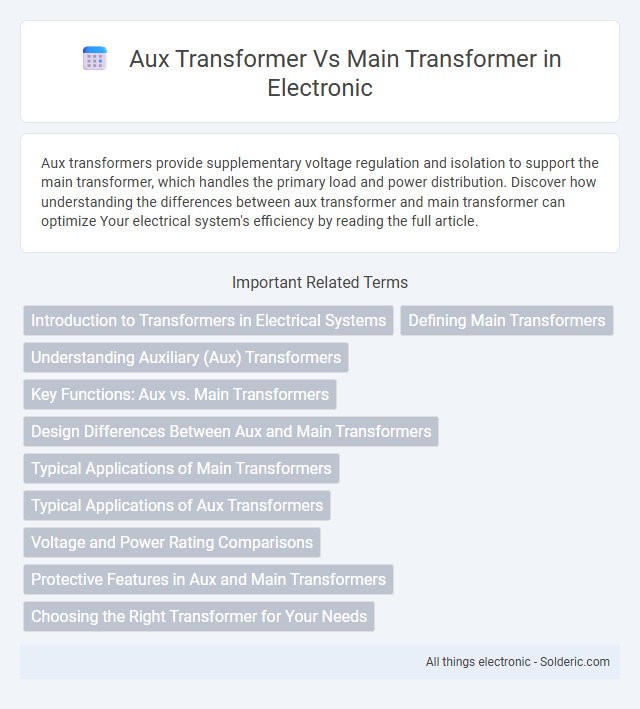Aux transformers provide supplementary voltage regulation and isolation to support the main transformer, which handles the primary load and power distribution. Discover how understanding the differences between aux transformer and main transformer can optimize Your electrical system's efficiency by reading the full article.
Comparison Table
| Feature | Aux Transformer | Main Transformer |
|---|---|---|
| Purpose | Supplementary tasks, enhancing main model performance | Primary model for core transformer-based tasks |
| Architecture | Often smaller, fewer layers and parameters | Full-scale transformer architecture |
| Training | Trained on auxiliary objectives or secondary data | Trained on primary task with main dataset |
| Use Case | Improves accuracy via supplementary signals | Handles main sequence modeling tasks like NLP, vision |
| Computational Cost | Lower than main transformer | Higher due to extensive layers and parameters |
| Integration | Used alongside main transformer for better representation | Stand-alone for direct inference and generation |
Introduction to Transformers in Electrical Systems
Auxiliary transformers supply power to control circuits, protection devices, and auxiliary equipment, ensuring the main transformer operates efficiently. Main transformers handle high-voltage power transmission between grids and substations, stepping voltage levels up or down to meet system requirements. Your electrical system's reliability depends on the coordinated function of both transformer types tailored to their specific roles.
Defining Main Transformers
Main transformers are critical electrical devices designed to transfer high-voltage electricity efficiently between power grids and distribution networks. They operate by stepping voltage levels up or down using electromagnetic induction, ensuring safe and reliable power delivery. Unlike auxiliary transformers, main transformers handle the primary load and maintain system stability in large-scale electrical infrastructure.
Understanding Auxiliary (Aux) Transformers
Auxiliary (Aux) transformers provide low-voltage power to control circuits, protection relays, and instrumentation within electrical substations or industrial systems, ensuring reliable operation of main equipment. Unlike main transformers that handle high-voltage power transmission and distribution, aux transformers step down voltage levels to safer, manageable levels for auxiliary devices. Their design emphasizes stable voltage output and isolation to support sensitive control and monitoring systems.
Key Functions: Aux vs. Main Transformers
Aux transformers primarily serve support functions, such as voltage regulation and supplying power to auxiliary circuits and control systems. Main transformers handle the bulk transfer of electrical power, stepping voltage levels up or down between generation and distribution networks. The distinction centers on capacity and role, with main transformers managing high-load transmission while aux transformers focus on auxiliary support and system stability.
Design Differences Between Aux and Main Transformers
Aux transformers are designed to supply power to auxiliary systems with lower voltage and current requirements, featuring compact cores and fewer windings compared to main transformers. In contrast, main transformers handle higher voltages and power loads, incorporating larger cores, multiple windings, and advanced insulation to manage electrical stress. Your system efficiency depends on selecting the appropriate transformer type based on these key design differences.
Typical Applications of Main Transformers
Main transformers are essential in power distribution networks, providing voltage regulation for the efficient transmission of electrical energy across long distances. They are commonly used in substations, industrial plants, and utility grids to step up or step down voltage levels, ensuring compatibility with end-user equipment. Their robust design supports high capacity loads and continuous operation, making them indispensable for primary power management.
Typical Applications of Aux Transformers
Auxiliary transformers are primarily used in industrial plants and power distribution systems to supply control circuits, instrumentation, and auxiliary equipment with stable, low-voltage power separate from the main transformer. Main transformers handle large-scale voltage step-up or step-down duties in power generation and transmission, whereas aux transformers ensure reliable operation of protective relays and monitoring devices. Typical applications of aux transformers include supplying power to motor control centers, lighting systems, and backup battery chargers critical for operational safety.
Voltage and Power Rating Comparisons
Auxiliary transformers typically operate at lower voltage levels ranging from 110V to 600V and have power ratings between 10 kVA and 500 kVA, designed to supply control circuits and auxiliary equipment. Main transformers handle higher voltage classes from 11 kV up to 765 kV and exhibit power ratings that span from hundreds of kVA to several hundred MVA, essential for bulk power transmission and distribution. Voltage regulation in main transformers is critical for grid stability, whereas auxiliary transformers prioritize safety and reliability for secondary circuits.
Protective Features in Aux and Main Transformers
Auxiliary transformers incorporate protective features such as overcurrent relays, fuses, and thermal sensors to safeguard against electrical faults and overheating in control circuits. Main transformers feature advanced protective devices like Buchholz relays, pressure relief devices, and differential protection schemes to detect internal faults, prevent catastrophic failures, and ensure operational reliability. Both transformer types emphasize insulation monitoring and temperature control to enhance durability and safety in electrical power systems.
Choosing the Right Transformer for Your Needs
Choosing the right transformer involves evaluating the application requirements and power capacity, where the main transformer handles primary voltage transformations in power distribution systems and the auxiliary transformer supports secondary or control circuits with lower power ratings. Main transformers are essential for stepping voltage up or down across transmission substations, ensuring efficient bulk power transfer, while auxiliary transformers supply stable power for equipment like protection relays, control panels, and lighting within the substation. Selecting between an auxiliary or main transformer depends on load characteristics, voltage levels, and operational roles, with the main transformer prioritized for high-capacity energy transfer and auxiliary transformers for supporting electrical infrastructure and operational reliability.
aux transformer vs main transformer Infographic

 solderic.com
solderic.com